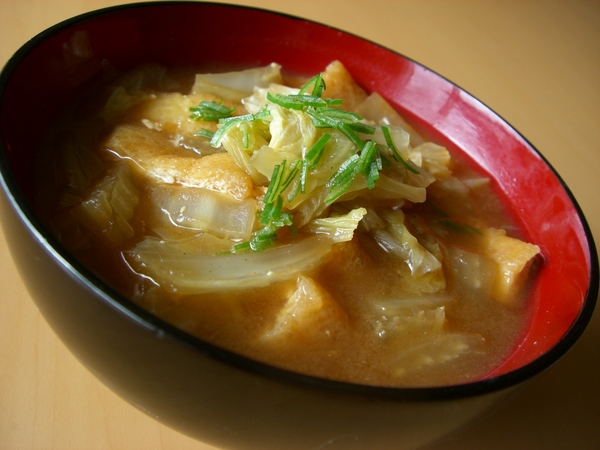Miso Soup with Eggplant and Okra, 茄子とオクラの味噌汁 [Recipes, All Seasons 1年通]
日本語のレシピは ビーガン、ベジタリアン情報満載の Hachidory から ご覧下さい。
The long hot summer has closed its curtain.
The autumn wildflowers which I farewelled a year ago has started greeting me again during my walk.
I also meet the various kinds of insects. The early autumn seems to be the best season for them to live the fullest, some are flying actively, some are hopping joyfully, and some are perching on the grass quietly.
My second pleasure in the morning is the breakfast, the regular simple meal that also gives me the energy for the day.
it is rice, Natto/fermented soybeans with grated radish, green onion and plum vinegar, seasonal vegetable pickles, Nori sea vegetable and Miso soup.
Miso soup definitely tastes better when the air is cooler.
My first sip of Miso soup gives me the great satisfaction.
This is the plain miso soup without any other ingredients except dashi and miso. I like this simple miso soup too.
So I am going to share another miso soup recipe today.
But before going to the recipe, let me talk about Miso for those who are interested in knowing about it.
If you do not need the talk and want the recipe straight away, just scroll down to the next page.
Miso is the fermented soybeans fermented together with the salt and grains such as rice and barley which are fermented with koji mold which is named Aspergillus Oryzae in English.
(I’m now not sure if this sentence is appropriate or not to make you understand.)
Miso is a traditional seasoning and consumed daily even in this modern society in Japan.
The most popular miso dish is Miso soup and it often goes with a bowl of rice in Japanese cuisine.
It is also used for marinating vegetables, for seasoning the dishes, even for sweets making.
If you visit the supermarket in Japan, you will see various kinds of Miso displayed. Some are pale yellow, some are brown, some are dark brown, and all of them showing catchy phrases on the label which might make you more confused, wondering what the differences are.
I’m afraid to say this, but unless you can read the description of
the ingredients which are usually written in the small letters on a small label or small area, you cannot know the minimum information about that particular miso.
I very seldom buy miso as I make it myself, but if I need to purchase, I would choose the one that the number of ingredients is three only. As I mentioned earlier the traditional miso is made from only three ingredients, so all the other items other than those three are something unnecessary (but probably necessary for mass production and mass market.)
I hope my preference could be one of the gauges to decide which one to take for you.
If you want to know more about the differences of Miso in details, and you can read Japanese, visit this page of “Hachidory”, where I contribute my recipes monthly in Japanese.
I am offering “Miso Making and Japanese Vegan Meal” in Airbnb Tokyo Experience.
In this experience, we make miso together, and I give a casual lecture about miso, and you can also enjoy lunch of my hand made Japanese vegan dishes using miso.
So if you have chance to visit Japan, join me to learn more about miso and also how to make miso.
I hope I can see you in Japan some day !
The recipe that I’m going to share with you today is “Miso Soup with Eggplant, Okra and Fried Tofu” as the eggplants and okra are now seasonal.
But actually you can use any ingredients of your choice to enjoy miso soup.
Here are some examples.
Miso soup with pumpkin, carrot, onion and cabbage
https://kurinascooking.blog.ss-blog.jp/2022-10-19
Miso soup with sweet corns, cucumber and tomatoes
Miso soup with napa cabbage and fried tofu
Miso soup with eggplant, myoga and shiso herb
Miso soup with winter vegetables and sake lee
https://kurinascooking.blog.ss-blog.jp/2018-02-02
Well let’s go to the recipe !
Soup Stock for Japanese Cooking 昆布だしといろいろなだし [Recipes, All Seasons 1年通]
日本語のレシピは ビーガン、ベジタリアン情報満載の Hachidory から ご覧下さい。
The soup stock called “Dashi” is basic item for Japanese cuisine as most of the Japanese dishes require Dashi in its cooking process.
In traditional Japanese cuisine, the smoked bonito fish or dried small sardine are used together with the sea vegetable called Komobu.
However in my vegan diet and cooking, I utilize only vegetables to make tasty Dashi.
Today I’m going to introduce you the several ways to make vegan Dashi, and share a recipe of “昆布だしKobudashi / Soup stock from Kombu sea vegetable” at the end.
Those soup stocks are useful to make miso soup, soup noodles such as ramen and udon, simmered vegetables and so on.
Extend your Japanese cooking experience with those Dashi, and enjoy Japanese vegan food of your own !
The soup is gentle and sweet, and I use this one almost everyday for making soup or cooking rice during sweetcorn season.
Ref. : Sweetcorn Rice
The cores of broccoli and cauliflower and the water used for blanching the flower parts of those vegetables and Komatsuna leafy green vegetables.
If the soup is with various kinds of vegetables including root vegetable, just adding a small piece of Kombu is enough to make nice soup as those vegetables release their umami into the soup.
Ref.: Vegan Stew with Sake Lee


_00001-1cccb.jpg)
_00001_01.jpg)

-9bf33.jpg)
2075020x20562-a7668.jpg)
_00001-08a33.jpg)
-6a8d4.jpg)




